The Aviation Department (luchtvaartafdeling / LVA)
version July 5 2019
Like other countries, the Dutch army also started experimenting with the use of the "air component".During manoeuvres in September 1911, both balloons and airplanes were taking part. This participation was a result of a commission, established in 1910, that had as assignment the use of aviation for the defense of the country. The foucus would be on reconnaissence. Because the Army didn’t have any airplanes, private owners were asked to participate. The weather, and lack of gas, reduced the availability of the airplanes. The balloons couldn’t operate at all.
Captain Walaardt Sacré, member of the commision, however was positive about the results. The potential was there, but practice was needed. The army would need its own planes for this, and experienced officers.
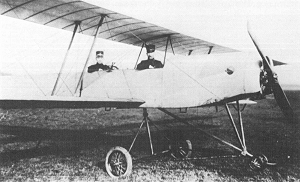
Jacques Labouchère, in front: capt Walaardt Sacré in de Zodiac, Manoeuvres September 1911
Source: Aviateurs van het eerste uur, Schoenmaker, W. & Postma, Th. 1984.
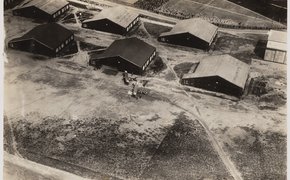
Soesterberg, 1918 – 1920
source: National Military Museum (NMM)
Tasks of the LVA would be guarding and reconnoitering the borders. The primary task would be in reconnaissance for the army and cooperating with artillery. The first airplane the LVA owned was “de Brik”, built by Dutch aircraft pioneer van Meel. It was bought on September 6, 1913. The plane was hired before to train the first 3 military pilots. It’s registration was LA-1, had a 50 hp Gnome engine, could reach a speed of 100 km/h and a height of 1880 meters. It cost the government fl 3,500

FA van Heyst, the first holder of a military brevet, with the Brik1
source: internet
In 1914, van Meel delivered his 2nd plane: “ Brik 2”, registration LA-5, with an 60 hp engine. It could reach a height of 2,000 meters.
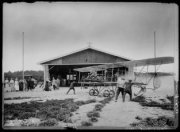
Brik 2
Source: Dutch Institute of Military History (NIMH)
Besides Soesterberg, there were airfields at Arnhem, Venlo, Gilze-Rijen and Vlissingen (focus on the southern and eastern borders).
During the WW1, the LVA faced several problems that made it difficult to grow a a fighting force. There was no real domestic aviation industry. Fokker was working in Germany, Koolhoven for France and Britain. The only available manufacturer was Henri Wijnmalen, then located at Soesterberg. He later moved to Amsterdam, in the former Spyker Automobile Factory. The enterprise was called Trompenburg (one of the streets it was located on).
The Army High Command approved of this move, because it brought the aircraft production within the Lines of Amsterdam, the Dutch National Redoubt.
Unfortunately, Trompenburg wasn’t a succesfull company and it needed much government support to avoid going bankrupt. Raw materials and (spare) parts weren’t available and difficult to acquire. Only in 1915 the first of 14 licensed build Farmans, outdated by then, were delivered. 3 of these were for the MLD. The development and production of an own airplane didn’t go too well either. An order of 72 fighter planes resulted in only 1 delivered, after the war had already ended. Only some trainers were successfully delivered.
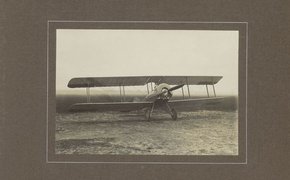
Prototype Trompenburg (Spijker) V.2 on Soesterberg, april 1918
Source: National Military Museum (NMM)
In France, 5 Nieuport-18 CI and 5 Caudron G IV scouts were ordered in 1916. However, they were only delivered in 1918, due to the war circumstances. The planes weren’t leading technology at that time anymore.
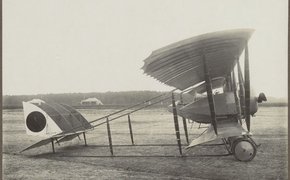
Caudron G.IV from the Luchtvaartafdeeling (registratienummer C-427), april-nov 1918
Source: National Military Museum (NMM)
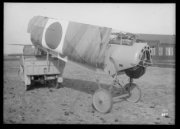
arrival of first Fokker D-II at Soesterberg, October 1, 1917
Source: Dutch Institute of Military History (NIMH)
The costs of these airplanes were fl 370,000. However, due to the shortages in Germany, they were paid with 5,000 young horses.
Another, unexpected, source for strengthening the LVA came from (crash) landing aircraft from the warring parties. In accordance with its neutrality, the government had to intern these (and their crew).
From the 107 that landed in the Netherlands, 69 (other source mentions 30) were used to reinforce the LVA. The rest was damaged too much or used for spare parts.

interned English bomber type De Havilland Airco DH.9 de (registration H433, ex B7620 "A") on Soesterberg, with the Dutch orange markings
Source: National Military Museum (NMM)
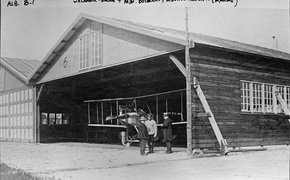
Albatros B.I (03) scout plane in hangar 6 on Soesterberg
Source: National Military Museum (NMM)
NB: The orange circles om the wings were the Dutch Nationality marks. In 1921 they were change to the current roundrel, because the orange one looked too close to the Japanese.

1921 LVA roundrel; also currently used for RNLAF
Source: internet

LVA roundrel WW2
Source: internet
Aerial photography was aided by the internment of a German plane in Venlo in September 1915. The same year LVA started with systematic recording of parts of the defenses. In 1916 a camera made in the Netherlands for this purpose.
Communications between "ground" and "air" also had to be developed. Use was made of existing knowledge within the army, mobilised students and systems acquired via internment. It took time and testing, but in April 1917 for the first time a message was send successfully to an airplane, in July it was also possible to send back. To support this, the army had 3 mobile radiotransmitters, with a range of 150 – 200 km. They came in service in 1916.
The war also increased the load of the Aviation Department:
- it had to be able to act defensively against enemy airplanes
- it had to be able to bomb enemy positions
- 116 fighters
- 108 scout aircrafts
- 24 artillery planes
- 20 trainers
The end of the war, strangely enough, made the problem of the (lack of) domestic avation industry disappear. After the armistice, Fokker smuggled / transported most of his inventory (“Several train loads of aeronautical goodies.....over 200 airframes and 400 engines”; thanks to @RichardClem for the additional info) to the Netherlands. After first associating himself with the Trompenburg Factories, he created his own company in 1919. Documentation used:
“100 jaar luchtmacht” (100 years airforce)
Helfferich, W.
2013
Het luchtmachtboek (the airforce book)
Kaufman, H., Loo, E. van, Winter, R. de [NIMH]
2014
Verre van vredig (Far from peaceful)
Staarman, A [Army museum, currently NMM]
2004
Nederland Neutraal (Netherlands Neutral)
Klinkert, W., Kruizinga, Samuel, Moeyes, P.
2014
Comments are welcome.